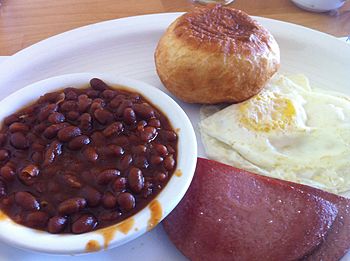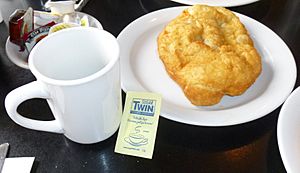Touton facts for kids

Beans, a touton, fried egg and bologna.
|
|
| Alternative names | Tiffin, touton, touten, towtent, damper dogs, damper devils |
|---|---|
| Type | Fried bread dough |
| Place of origin | Canada |
| Region or state | Newfoundland |
| Main ingredients | Bread dough, butter or pork fat |
Touton is a popular traditional food from Newfoundland and Labrador (NL), Canada. It's usually a pancake-like dish made from bread dough that has risen. Even though people don't often make pancakes from homemade bread dough in Newfoundland today, many still remember the special names for this dish. Toutons are often served for breakfast or brunch. You can still find them on the breakfast menus of many local restaurants.
Contents
Types of Toutons
Fried Bread Dough Toutons
The most common type of touton is made by frying bread dough in a pan with butter or pork fat. Frying bread dough isn't just a Newfoundland thing; other places have similar dishes. For example, Acadian people make something called Croix en d'Jeu.
Toutons were often made from leftover bread dough. Sometimes, the dough was left to rise overnight. People in places like North River would flatten the risen dough like a pancake. Then they would fry it in pork fat or margarine. It was usually a breakfast food because bread dough was often mixed in the evening and baked the next day.
Sometimes, toutons were a special treat for children. This was to keep them from eating all the freshly baked bread! There wasn't a strict recipe for toutons. People usually learned how to make them from their families. For example, Mary (Murphy) King from Ship Cove said her mother would just "mix a bit of this and a bit of that." This surprised American soldiers who visited, as they expected a written recipe!
Today, it's rare to find toutons cooked in pork fat. Restaurants usually fry them in olive oil, clarified butter, or canola oil.
Tiffin Toutons
Tiffin is another common name for toutons, especially in the Bonavista Bay area. It's also used in parts of Central Newfoundland and Labrador. The name tiffin can also mean "small lunch" in some places.
Making tiffins is similar to making other toutons. One person from Bonavista Bay said that when her mother made bread, she would cut off pieces of risen dough. She would then fry them, and these were called tiffins. Some people also call them scons. Other names include tiffen-bread and sintiffin.
What to Eat with Toutons
Traditionally, toutons are served with a drizzle of molasses or a pat of butter. Sometimes, people use maple syrup, sugar, corn syrup, or fruit jam. However, some people who love traditional food think these are not the right toppings.
Another option is "coady" (also called cody or lassy coady). This is a sauce made from molasses. To make it, you boil molasses, water, butter, and vinegar together.
Baked Salt Pork Buns
In some parts of Newfoundland, a touton is a baked cake or bun. These are often made with small pieces of salted pork mixed into the dough.
In 1971, Marie Harris from Glovertown shared an old Newfoundland recipe. It was for a plain tea cake made with flour, sugar, water (or milk), butter, salt, and small pieces of white pork. This mixture was rolled into a dough and cut into circles. The cakes were then baked in an oven. They could be eaten hot or cold. These were not to be confused with the fried tiffins!
Another description from 1964 said that these toutons were made with flour, pork, and baking powder. They were rolled and then baked.
Potato Toutons
Another type of touton uses potatoes as the main ingredient. These were made in the Bonavista and Elliston areas of the Bonavista Peninsula. People have been making them since the early 1900s.
Other Names for Toutons
There are many different regional names for toutons. It can be tricky because some names might refer to different types of toutons. Also, some names like bang belly or flapjacks can also mean other foods.
Here are some of the other names:
- bang belly (also other baked buns)
- cushions (Western Newfoundland)
- damper dogs (St. John's)
- damper devils (possibly St. John's)
- dicky dough (Trinity Bay)
- dunkie doughs (Random Island)
- fan-titties (Jackson's Arm)
- flacoons (Freshwater, Placentia Bay)
- flackers (Stephenville Crossing)
- flapjacks (Fortune Harbour, also a type of pancake)
- flats (Bonavista)
- flitters (Lumsden, also Great Northern Peninsula)
- flummy/flummies (Northwest River, Labrador)
- freezie (Central Newfoundland)
- fried dough (Red Bay)
- frozie (Calvert; Bishop’s Falls; Bonavista Bay; southern Labrador)
- gandies (Fischells; St. George's; Stephenville)
- gangees (Point Leamington)
- luski/luskinikn (traditional Mi'kmaq food, similar to bannock)
- pan cakes or pan bread (Cartwright)
- panitsiak (Nunatsiavut, similar to bannock)
- pooies (Bay Roberts)
- posies (Northern Bay)
- puffy-ups (Possibly Bonavista)
- scons (Miawpukek; also Wesleyville)
- stove cakes (L’anse au Diable, Labrador)
- tommy's/tommies (Hooping Harbour; Harbour Deep)
- touten (Elliston)
- toutins (North River, Conception Bay)
- toutons with holes in them (Point Leamington, Fortune Harbour)
- towtents (pork cakes)
- tushin
- zachingles/sachingiels (Cape St. George / Mainland)


